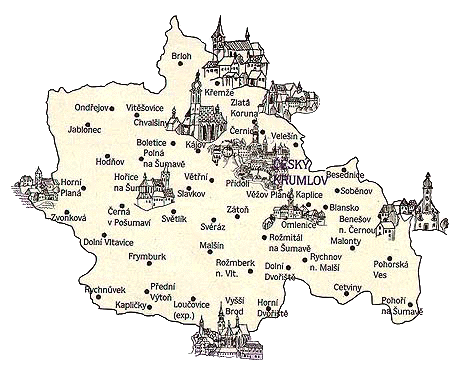Ecclesiastical Objects in the Český Krumlov Region
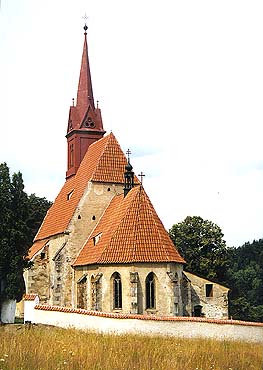 The region of Český
Krumlov is exceptionally rich in ecclesiastical architecture -
there are over 40 churches and tens of chapels and wayside columns.
The building of ecclesiastical structures came with the continuous
population and colonisation of sparsely populated wooded areas,
that belonged to the king. Part of this area was given by the Czech
ruler to the ownership of the Benedictine monastery of Ostrov near
Praha. The monastery built the church
of sv. Jana Křtitele (St. John the Baptist) in Zátoň and it is
one of the oldest churches in this region. The church was rebuilt
at the turn of the 15th and 16th centuries in the Gothic style and
from the former building only the masonry of the presbytery and
sacristy remained. Another old church is the church of St. Mikuláš
in Boletice. It was rebuilt in the second half of the 15th century
as well as the church in Zátoň. Some architectural details suggest
its Romanesque outlook - masonry in the nave and the matching tower
windows.
The region of Český
Krumlov is exceptionally rich in ecclesiastical architecture -
there are over 40 churches and tens of chapels and wayside columns.
The building of ecclesiastical structures came with the continuous
population and colonisation of sparsely populated wooded areas,
that belonged to the king. Part of this area was given by the Czech
ruler to the ownership of the Benedictine monastery of Ostrov near
Praha. The monastery built the church
of sv. Jana Křtitele (St. John the Baptist) in Zátoň and it is
one of the oldest churches in this region. The church was rebuilt
at the turn of the 15th and 16th centuries in the Gothic style and
from the former building only the masonry of the presbytery and
sacristy remained. Another old church is the church of St. Mikuláš
in Boletice. It was rebuilt in the second half of the 15th century
as well as the church in Zátoň. Some architectural details suggest
its Romanesque outlook - masonry in the nave and the matching tower
windows.
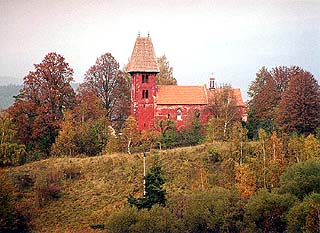
|

|
In the connection with colonisation of this region by the Witigonen family, and Cistercian monks from the monastery in Vyšší Brod and the monastery of Zlatá Koruna came to found new towns and villages. An important part of these are the parish churches.
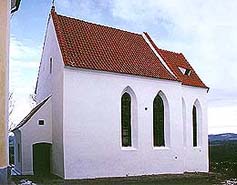
|

|
During the second half of the 13th century and all of the 14th century the system of parishes continued and this system has not shown major changes in all of the following centuries. The origin of the churches in the Middle Ages in the region of Český Krumlov can be seen by the saints they were consecrated to, who were typical for this time, for example St. Jan Křtitel (Zátoň), St. Petr and Pavel (Svéráz, Kaplice), St. Jiří (Blansko), St. Mikuláš (Boletice), Smrt Panny Marie (Death of the Virgin Mary - so-called little church in Kájov), St. Markéta (Horní Planá, the former church for the inhabitants of Zlatá Koruna), St. Kateřina (Hořice na Šumavě), and most common were those, that were consecrated to the apostles. The churches from the 15th century were becoming already too small during the 14th century and therefore they were rebuilt together with the foundation of new cathedrals.
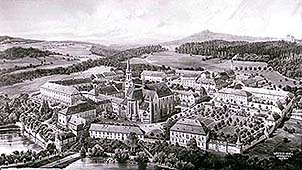
|

|
The Hussite wars after 1420 didn't bring too much damage to the church buildings in this region as was the case in other parts of the Czech territory, because the owner of the Český Krumlov estate, Ulrich II. von Rosenberg (1403-1462) belonged to the important members of the Czech Catholic nobility and the local population remained mostly Catholic. In cases where the churches were damaged (for example Kájov Pilgrimage Church, Světlík), they were gradually repaired. The monastery of Zlatá Koruna received severe damage, it was plundered by Hussites in 1420 and part of its estate fell into the hands of the Rosenbergs, who took it as a security. In spite of that the monastery of Zlatá Koruna had never ceased to exist and under very austere material conditions reviewed its activity.
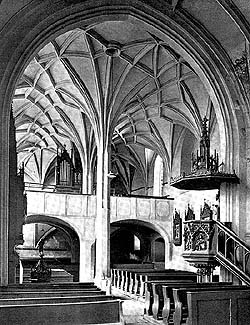
|

|
On the other hand the second half of the 15th century showed an intensive building activity that led to the Gothic rebuilding of parish churches in the region of Český Krumlov. For the Gothic rebuilding of churches the typical signs are complicated reticulated vaults with crossed or arched spanned ribs, which served more a decorative than functional purpose. Reticulated vaults give us the impression of unusual artificial beauty which is typical for the Late Gothic art. The origin of these architectural details is already noticeable in the building of the iron works of Petr Parleř and after its demise, these architectural elements were used in Austria and Bavaria by the workers of Praha's iron works, who came here after leaving Praha. In the second half of the 15th century these architectural elements came back to the Czech lands in an enriched form.

|
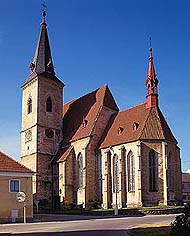
|
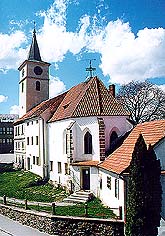
|
In the region of Český Krumlov a peculiar building style of a double nave with a reticulated vault became popular, proving the high level of the Late Gothic in South Bohemia. The dual nave was not meant to be used as a non liturgical space - as halls, capitular halls and sacristies.
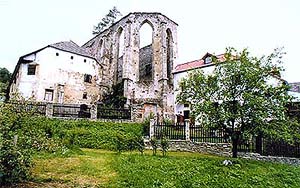 The first dual nave for
a cathedral already appeared in 1360 in the Praha's church of
Panny Marie Na trávníčku. In the centre of Bohemia this
architectural style had not been used too frequently it only became
popular in the second half of the 15th century in South Bohemia.
Part of this popularity had been caused by the influence of the
architecture of Passau where the use of a dual nave was quite
common. The ties with this district and the region of Český
Krumlov, were always close. The use of a dual nave was also
advantageous from the practical point of view. A lot of churches
were in the building process or the original masonry was being
used, and the whole structure could not be accomplished without
these free standing objects. The dual nave has been used in
rebuilding the pilgrimage church in Kájov, the churches in
Chvalšiny, Malonty, Velešín, Hořice na Šumavě, Kaplice and Rychnov
nad Malší. Among the other important rebuilt churches in the Gothic
style belong the churches of Dolní Dvořiště, Rožmberk nad Vltavou
and many others. The architecture of the churches had influenced
each other and mutual similarity can be observed quite often.
The first dual nave for
a cathedral already appeared in 1360 in the Praha's church of
Panny Marie Na trávníčku. In the centre of Bohemia this
architectural style had not been used too frequently it only became
popular in the second half of the 15th century in South Bohemia.
Part of this popularity had been caused by the influence of the
architecture of Passau where the use of a dual nave was quite
common. The ties with this district and the region of Český
Krumlov, were always close. The use of a dual nave was also
advantageous from the practical point of view. A lot of churches
were in the building process or the original masonry was being
used, and the whole structure could not be accomplished without
these free standing objects. The dual nave has been used in
rebuilding the pilgrimage church in Kájov, the churches in
Chvalšiny, Malonty, Velešín, Hořice na Šumavě, Kaplice and Rychnov
nad Malší. Among the other important rebuilt churches in the Gothic
style belong the churches of Dolní Dvořiště, Rožmberk nad Vltavou
and many others. The architecture of the churches had influenced
each other and mutual similarity can be observed quite often.

|
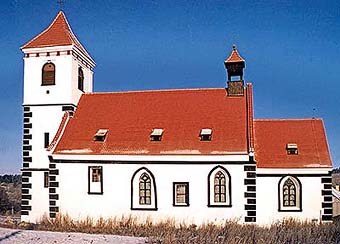
|
At the end of the 15th century the monastery churches were being built for the religious orders in Kuklov and Přední Výtoň. The monastery of the Paulines was established by the Rosenbergs in 1495 in Kuklov (Castle and Monastery of Kuklov). The hermits - eremites of St. Pavel Thébský settled from the 14th century in Přední Výtoň by the church of St. Filip and Jakub. There they had their own house of the order. Both religious communities had disappeared during the first half of the 16th century. It was the time of general decline of monasteries - among them even the convent of Zlatá Koruna.
Most of these building activities had been realised thanks to the generosity of the Rosenberg family. They established their own iron works in 1497 with the iron works in Passau as a model, at first at its helm stood Hans Getzinger and
 later Ulrich Pesnitzer
from Burghausen. The favourable location of the region enabled the
spreading of artistic ideas from Austria and Bavaria - which can be
seen on the building of the above mentioned iron works. The stone
masons were mostly Germans.
later Ulrich Pesnitzer
from Burghausen. The favourable location of the region enabled the
spreading of artistic ideas from Austria and Bavaria - which can be
seen on the building of the above mentioned iron works. The stone
masons were mostly Germans.
During the 16th century the building activity is comprised mostly by finishing the rebuilding and improvement of the churches which began in the previous century. There was no strong influence of the Renaissance in the ecclesiastical architecture. The tradition of the Late Gothic style was in this field exceptionally strong and we cannot ignore the strong conservatism in this sphere.
Another move of building activity comes in the time of Baroque. It brings the higher interest in religion in connection with the re-Catholisation after the battle of Bílá Hora (1620) and with the whole spiritual climate of the 17th century, which is characterised by the strong interest in religious matters. The net of spacious churches rebuilt in the style of the Late Gothic was sufficient. The region of Český Krumlov was traditionally a Catholic district and therefore there had been no need for the
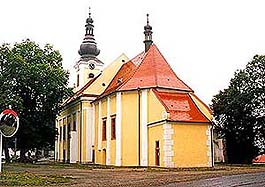 building of the churches
as was the case in other parts of Bohemia. However, most of the
cathedrals were rearranged in the Baroque style, but all these
alterations could not hide the dominant Gothic character of these
structures. For example the church of the Narození Panny Marie
(Birth of the Virgin Mary) in Cetviny had been rebuilt in the years
1735-36 . The original church dated back to the 14th century. An
exception is the church in Velešín. The former Gothic dual nave was
replaced by a single nave in Baroque style. Another exception is
the church in Brloh, which has been completely rebuilt. In the
first third of the 18th century new churches were built in Ondřejov
and Omlenička and the Svatý
Kámen Pilgrimage Church was finished allegedly at the place of
the revelation of the Virgin Mary. The Baroque alterations and the
new buildings could not exceed the quality of the Late Gothic and
were only at the level of contemporary construction.
building of the churches
as was the case in other parts of Bohemia. However, most of the
cathedrals were rearranged in the Baroque style, but all these
alterations could not hide the dominant Gothic character of these
structures. For example the church of the Narození Panny Marie
(Birth of the Virgin Mary) in Cetviny had been rebuilt in the years
1735-36 . The original church dated back to the 14th century. An
exception is the church in Velešín. The former Gothic dual nave was
replaced by a single nave in Baroque style. Another exception is
the church in Brloh, which has been completely rebuilt. In the
first third of the 18th century new churches were built in Ondřejov
and Omlenička and the Svatý
Kámen Pilgrimage Church was finished allegedly at the place of
the revelation of the Virgin Mary. The Baroque alterations and the
new buildings could not exceed the quality of the Late Gothic and
were only at the level of contemporary construction.

|

|
The church was the centre of the whole village, it was visited regularly by the population of the parish during the church and devotion services, and celebrations. It was also connected to special events in human life, for example the christening of children, weddings and funerals.
 In many churches were
religious brethren's sections, which carried out their own
religious services and pilgrimages. From spring until winter rows
of pilgrims passed through the countryside which led not only to
pilgrimage places but also to parish churches, during the name's
day of that particular church. For example during the 17th century
the parishioners of the Kájov parish organised nine processions to
surrounding churches. These activities contributed to the general
feeling of belonging.
In many churches were
religious brethren's sections, which carried out their own
religious services and pilgrimages. From spring until winter rows
of pilgrims passed through the countryside which led not only to
pilgrimage places but also to parish churches, during the name's
day of that particular church. For example during the 17th century
the parishioners of the Kájov parish organised nine processions to
surrounding churches. These activities contributed to the general
feeling of belonging.
We cannot forget the importance of numerous chapels, small chapels, wayside columns, and crosses which were spread across the countryside, this was a way to express religious believes during the Baroque period and people's feelings towards the countryside. These small structures, which were often situated on very prominent places, like tops of hills, by water wells, great boulders or magnificent trees, finished the moulding of the countryside and gave it a feeling of sacredness. In the eyes of a person in the Baroque period, the surrounding countryside changed into a land of miracles, with many places having connection with the intervention of St. Mary, angels and saints.
In the last third of the 18th century several new churches were built, which in some cases replaced original wooden chapels. The building of these also gave rise to several new villages and with the reforms of the Emperor Josef II,
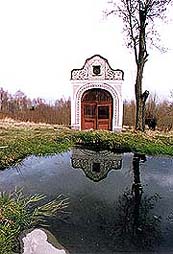
|

|
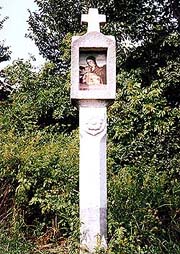
|
 which supported the
establishment of churches, so that people from distant villages had
easier access. The enlightened state thought that the building of
new churches will be beneficial to the country's administration,
because the priests had been ordered to announce all the changes in
the state regulations, and orders from the pulpit, and contribute
with their work to the enlightenment of the population. The
majority of the churches had a similar structure. They consisted of
a single nave body with an apse either a right-angle or three
sectional, and a smooth front face. Similar churches were also
built in Pohoří na Šumavě, Pohorská Ves, Černá v Pošumaví, Hodňov
and Věžovatá Pláň. Their patronage reflected the Baroque culture of
St. Mary, St. Anna and the Holy Trinity.
which supported the
establishment of churches, so that people from distant villages had
easier access. The enlightened state thought that the building of
new churches will be beneficial to the country's administration,
because the priests had been ordered to announce all the changes in
the state regulations, and orders from the pulpit, and contribute
with their work to the enlightenment of the population. The
majority of the churches had a similar structure. They consisted of
a single nave body with an apse either a right-angle or three
sectional, and a smooth front face. Similar churches were also
built in Pohoří na Šumavě, Pohorská Ves, Černá v Pošumaví, Hodňov
and Věžovatá Pláň. Their patronage reflected the Baroque culture of
St. Mary, St. Anna and the Holy Trinity.
During the following 19th century and the first half of the 20th century, only slight alterations took place, mainly to the new pseudo-style of church, which gradually replaced the original Baroque and Rococo content of the churches. Some of the churches were totally rebuilt, like the church in Křemže which was successfully rebuilt in the pseudo-Gothic style, and the church in Světlík which was altered in the pseudo-Romanesque style. Also simple chapels were being built on village greens, where church services were performed. The building of small chapels and crosses continues, which supports the strong religious feelings of the village population. These small structures usually came about as a thanks giving for being heard, or on a place of some tragic event, their building continued until the first third of the 20th century, when they are being replaced by monuments and memorials.
The evacuation of the German population after 1945 and the onset of communist rule of anti-religious principles after 1948,
 became a tragic event for
this region of Český Krumlov. The evacuation of the German
population led to the de-population of this region. Part of this
region became a closed border region or a military area for the use
of the army. The empty villages in these closed, inaccessible
regions have been liquidated including a number of churches, which
were demolished or very badly devastated. The churches in Ondřejov,
Jablonec and Vítějovice were totally demolished. Churches in Polná
na Šumavě, Boletice, Svatý Kamen, Svatý Tomáš and others had been
devastated. Some of the religious buildings have been demolished
with the construction of the Lipno dam, for example the church of
Dolní Vltavice.
became a tragic event for
this region of Český Krumlov. The evacuation of the German
population led to the de-population of this region. Part of this
region became a closed border region or a military area for the use
of the army. The empty villages in these closed, inaccessible
regions have been liquidated including a number of churches, which
were demolished or very badly devastated. The churches in Ondřejov,
Jablonec and Vítějovice were totally demolished. Churches in Polná
na Šumavě, Boletice, Svatý Kamen, Svatý Tomáš and others had been
devastated. Some of the religious buildings have been demolished
with the construction of the Lipno dam, for example the church of
Dolní Vltavice.
It is estimated that there were approx. 14 demolished or badly devastated churches in the Český Krumlov region in 1989. Small structures, like the little chapels and crosses have been systematically and purposefully demolished.
Many of the parish churches fell into disrepair thanks to vandalism and the non-interest of the new inhabitants, that had no roots, and came from other depopulated areas of the Czech countryside. These people formed no link with the local religious buildings, because they were strange and foreign to them. This was the effect of a strong decline in the religious belief which was not important, and was on the outside of their interests. Certain changes happened only with the social changes after 1989, where the border region was opened and also necessary reconstruction work was carried out on certain objects, very often with the financial support of people from Austria and Germany. The utilisation of these objects is still problematical, because the countryside is sparsely populated and the Christianity in this region is not strong.
Further information:
Places
of Pilgrimage in the Český Krumlov region
Ecclesiastical
History in the Český Krumlov region
Ecclesiastical
Objects in Český Krumlov
Ecclesiastical
History of Český Krumlov
St.
Michael's parochial church in Horní Dvořiště
Parish
church of St. Bartoloměj in Vyšší Brod
St.
Filip and Jakub parish church in Přední Výtoň
The
Church of St. Nicholas in Rožmberk nad Vltavou
Foundation
of the monastery in Vyšší Brod
Two
churches in Loučovice
The
Church of the Holy Christ´s Heart in the community of
Malšín
The
Extinct Parish of Kapličky
The
Extinct Parish of Rychnůvek
(zp)




